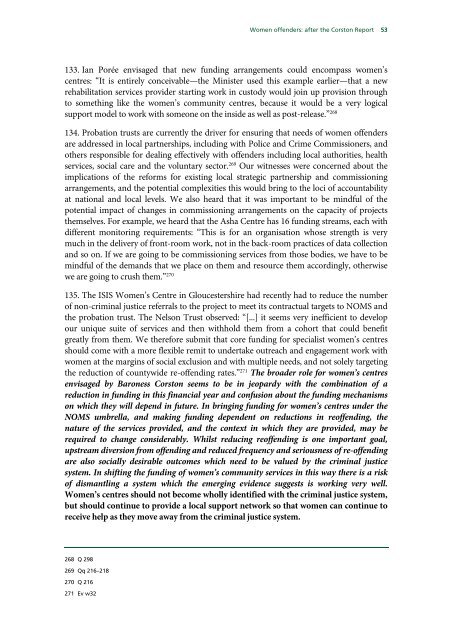Women offenders: after the Corston Report - United Kingdom ...
Women offenders: after the Corston Report - United Kingdom ...
Women offenders: after the Corston Report - United Kingdom ...
You also want an ePaper? Increase the reach of your titles
YUMPU automatically turns print PDFs into web optimized ePapers that Google loves.
<strong>Women</strong> <strong>offenders</strong>: <strong>after</strong> <strong>the</strong> <strong>Corston</strong> <strong>Report</strong> 53133. Ian Porée envisaged that new funding arrangements could encompass women’scentres: “It is entirely conceivable—<strong>the</strong> Minister used this example earlier—that a newrehabilitation services provider starting work in custody would join up provision throughto something like <strong>the</strong> women’s community centres, because it would be a very logicalsupport model to work with someone on <strong>the</strong> inside as well as post-release.” 268134. Probation trusts are currently <strong>the</strong> driver for ensuring that needs of women <strong>offenders</strong>are addressed in local partnerships, including with Police and Crime Commissioners, ando<strong>the</strong>rs responsible for dealing effectively with <strong>offenders</strong> including local authorities, healthservices, social care and <strong>the</strong> voluntary sector. 269 Our witnesses were concerned about <strong>the</strong>implications of <strong>the</strong> reforms for existing local strategic partnership and commissioningarrangements, and <strong>the</strong> potential complexities this would bring to <strong>the</strong> loci of accountabilityat national and local levels. We also heard that it was important to be mindful of <strong>the</strong>potential impact of changes in commissioning arrangements on <strong>the</strong> capacity of projects<strong>the</strong>mselves. For example, we heard that <strong>the</strong> Asha Centre has 16 funding streams, each withdifferent monitoring requirements: “This is for an organisation whose strength is verymuch in <strong>the</strong> delivery of front-room work, not in <strong>the</strong> back-room practices of data collectionand so on. If we are going to be commissioning services from those bodies, we have to bemindful of <strong>the</strong> demands that we place on <strong>the</strong>m and resource <strong>the</strong>m accordingly, o<strong>the</strong>rwisewe are going to crush <strong>the</strong>m.” 270135. The ISIS <strong>Women</strong>’s Centre in Gloucestershire had recently had to reduce <strong>the</strong> numberof non-criminal justice referrals to <strong>the</strong> project to meet its contractual targets to NOMS and<strong>the</strong> probation trust. The Nelson Trust observed: “[...] it seems very inefficient to developour unique suite of services and <strong>the</strong>n withhold <strong>the</strong>m from a cohort that could benefitgreatly from <strong>the</strong>m. We <strong>the</strong>refore submit that core funding for specialist women’s centresshould come with a more flexible remit to undertake outreach and engagement work withwomen at <strong>the</strong> margins of social exclusion and with multiple needs, and not solely targeting<strong>the</strong> reduction of countywide re-offending rates.” 271 The broader role for women’s centresenvisaged by Baroness <strong>Corston</strong> seems to be in jeopardy with <strong>the</strong> combination of areduction in funding in this financial year and confusion about <strong>the</strong> funding mechanismson which <strong>the</strong>y will depend in future. In bringing funding for women’s centres under <strong>the</strong>NOMS umbrella, and making funding dependent on reductions in reoffending, <strong>the</strong>nature of <strong>the</strong> services provided, and <strong>the</strong> context in which <strong>the</strong>y are provided, may berequired to change considerably. Whilst reducing reoffending is one important goal,upstream diversion from offending and reduced frequency and seriousness of re-offendingare also socially desirable outcomes which need to be valued by <strong>the</strong> criminal justicesystem. In shifting <strong>the</strong> funding of women’s community services in this way <strong>the</strong>re is a riskof dismantling a system which <strong>the</strong> emerging evidence suggests is working very well.<strong>Women</strong>’s centres should not become wholly identified with <strong>the</strong> criminal justice system,but should continue to provide a local support network so that women can continue toreceive help as <strong>the</strong>y move away from <strong>the</strong> criminal justice system.268 Q 298269 Qq 216–218270 Q 216271 Ev w32
















